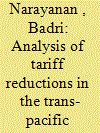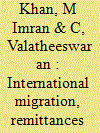|
|
|
Sort Order |
|
|
|
Items / Page
|
|
|
|
|
|
|
| Srl | Item |
| 1 |
ID:
142822


|
|
|
|
|
| Summary/Abstract |
Our purpose is to undertake a comparative analysis of the likely impact of tariff reduction under the Trans-Pacific Partnership (TPP) on various macro and trade variables of the Indian economy under different scenarios. The TPP was concluded in October 2015, but it is yet to be ratified by the partner countries, and while Asian giants like India, China and Korea have not joined the TPP, there are some talks about their joining the partnership in future. Ours is a unique study that evaluates India’s perspective on joining the TPP, in terms of tariff reduction, and not in terms of the removal of non-tariff barriers. We employ the widely used standard Global Trade Analysis Project (GTAP) model for this exercise. This is a unique framework with a global economy-wide approach, in a Computable General Equilibrium (CGE) setting. Five different scenarios of complete integration in terms of tariff reduction between different regions are simulated using the GTAP model. Under each scenario, the tariff among members of a group of regions is eliminated, but is unchanged for other regions. Higher welfare arising from allocative efficiency comes with the cost of a relatively lower consumption of domestic products and investment, resulting in a loss in terms of GDP. Therefore, we conclude that there are mixed prospects and no strong reason for India to pursue being part of the TPP in future, from a perspective of tariff reductions.
|
|
|
|
|
|
|
|
|
|
|
|
|
|
|
|
| 2 |
ID:
142823


|
|
|
|
|
| Summary/Abstract |
This study examines how remittances can influence economic growth under different levels of financial development. Using a dynamic panel estimation of 33 top remittance-recipient developing countries from 1979 to 2011, the results suggest that financial development neither works as a substitute nor a complement for the remittance–growth nexus. While remittances are effective in promoting economic growth, the influence of financial variables is found to be insignificant. More developed financial systems may attract more remittances; however, the interaction effect of financial development and remittances is not growth enhancing. Promoting financial literacy, reducing the cost of sending remittances through banks and encouraging the overall use of formal financial institutions may induce a stronger remittance–growth nexus.
|
|
|
|
|
|
|
|
|
|
|
|
|
|
|
|
| 3 |
ID:
142825


|
|
|
|
|
| Summary/Abstract |
The article examines the impact of international migration on the labour supply of male and female left-behind household members in both market and non-market work. In addition, we examine the labour supply behaviour of women whose husbands have migrated abroad. After controlling for potential endogeneity using the instrument variable (IV-probit) approach, estimates show that the supply of male and female left-behind members in market work decreases. While international migration results in the relocation of labour supply of male left-behind members from salary and casual wage workers to self-employed workers, it increases female left-behind members’ participation in household duties and reduces their participation in unpaid family work. The heterogeneity effect confirms that the impact of international migration is greater in rural than in urban areas.
|
|
|
|
|
|
|
|
|
|
|
|
|
|
|
|
| 4 |
ID:
142827


|
|
|
|
|
| Summary/Abstract |
This study examines the relationship between academics’ use of the Internet for academic purposes and their research performance using cross-sectional data collected from academics of the University of Southern Queensland (USQ), Australia, during the period February–March 2014. In this study, a system of simultaneous equation models is used to control the potential bias associated with simultaneity between the use of the Internet and academics’ research performances. The simultaneity, a potential econometric problem, was overlooked in past studies. A finding of this study is that academics’ use of the Internet is a statistically significant contributor to research output in an Australian university. The estimated elasticity of research output is 0.16 with respect to changes in Internet use.
|
|
|
|
|
|
|
|
|
|
|
|
|
|
|
|
| 5 |
ID:
142826


|
|
|
|
|
| Summary/Abstract |
In this article, we present a choice function of a rural household relating to her/his ward’s schooling. It makes an empirical evaluation on the basis of a simple theoretical framework using a primary data set surveyed from two backward districts of West Bengal. It explores the underlying causes of wards’ discontinuation of school by examining the choice function of the parents using ordered probit analysis. The likelihood of dropout is higher at the primary level for low-income households and significantly depends on parents’ attributes, which are mostly endogenous in an educational production function, and other exogenous difficulties in accessing school. It is also triggered by a lack of expectation about the future impact of education on a child’s life.
|
|
|
|
|
|
|
|
|
|
|
|
|
|
|
|
| 6 |
ID:
142824


|
|
|
|
|
| Summary/Abstract |
In Bangladesh, where tobacco use is pervasive, reducing tobacco use is economically beneficial. This article uses the latest Bangladesh social accounting matrix (SAM) multiplier model to quantify the economy-wide impact of demand-driven changes in tobacco cultivation, bidi industries and cigarette industries. First, we compute various income multiplier values (i.e., backward linkages) for all production activities in the economy to quantify the impact of changes in demand for the corresponding products on gross output for 86 activities, demand for 86 commodities, returns to 4 factors of production and income for 8 household groups. Next, we rank tobacco production activities by income multiplier values relative to other sectors. Finally, we present three hypothetical ‘tobacco-free economy’ scenarios by diverting demand from tobacco products into other sectors of the economy and by quantifying the economy-wide impact. The simulation exercises with three different tobacco-free scenarios show that, compared to the baseline values, total sectoral output increases by 0.92, 1.3 and 0.75 per cent. The corresponding increases in the total factor returns (i.e., gross domestic product, GDP) are 1.57, 1.75 and 1.75 per cent. Similarly, total household income increases by 1.40, 1.58 and 1.55 per cent.
|
|
|
|
|
|
|
|
|
|
|
|
|
|
|
|
|
|
|
|
|